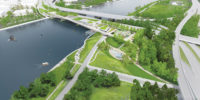In the Cause of Architecture
The Lesson of the Towering Inferno
A New York City Firefighter speaks out against lightweight skyscraper design
Editor's note: The essay that follows represents the opinions of its author only. Gregory Gargiso wrote a letter to the editors of Architectural Record, and he was invited to expand on his thoughts for In the Cause of Architecture. His ideas have proven to be somewhat controversial and possibly impractical, but the perspective of a working New York City firefighter may open up new lines of discussion about building design and construction, and In the Cause of Architecture supports Lieutenant Gargiso's right to express his views. At the same time, we invite responses to his ideas from design and construction professionals or anyone with informed ideas on the subject.
Okay, where do we begin here? The editors of Architectural Record asked me to write a piece because of a letter I wrote through email about what I thought should be done with the World Trade Center site. It was an open forum where people were weighing in about whether it should be built, shouldn't be built; make it a park, et cetera, et cetera. I weighed in with my personal experience of the building. As a firefighter in downtown Manhattan, I had responded to calls at the buildings (WTC and others) numerous times, too numerous to count, even. Also, I wrote that for promotion purposes, the New York City Fire Department rigorously tests its members on the types of buildings to which they most respond and fight fires in, high-rise office buildings included.
Up until September 11, private dwelling fires were the ones that were most lethal every year. I am sure they will regain that terrible status again this year. I guess the editors were struck by a reference to a movie I'm sure we've all seen, The Towering Inferno, in which, at the end, the fire chief played by Steve McQueen meets with the architect played by William Holden and says something like, "Maybe now they (the financiers, architects, bureaucrats, you get the idea) will listen to what we (the fire service) have to say."
Now, I am not accusing the aforementioned groups of denying the public any safety they need and deserve. I will say because of money and politics (those being the biggest two) that fire concerns—or, better yet, how fire treats the elements of the building—are relegated to a low position on the laundry list of concerns when a "super" or a "jumbo" gets erected. I know the flak is coming; I can hear people screaming already: "We do, we do, we always pay attention to the fire code and the building code." Maybe that's where the problem lies: the code. No code written is sufficient for two jumbo jets flying into buildings. After all, most of the toughest building codes written were written in hindsight. Look up the Triangle Shirtwaist Factory, where more than 200 women died, stuck inside. Now exits can't be blocked. Or look at how the 1998 fire at the Vandalia Houses in Brooklyn that killed three firefighters changed local law. My question is: why must there always be such a high price paid to learn these lessons?
To try to talk to architects and or engineers about their level of expertise about building construction would be laughable, so I won't. We do study building construction for the fire service, all different types; brownstones, frames, private dwellings, tenements, factories, high-rises. Primarily, what our tactics will be in each type, because fire behaves differently in each and every one because of materials and construction practices used there. We learn the dangers commonly associated with different types. For example, in private houses, the biggest disadvantage from a firefighting viewpoint would be the open stairway, which allows heat, smoke and flame to travel up unimpeded to the upper floors, which are probably sleeping areas.
Society's answer to this has been the smoke detector. As a firefighter, I would be thinking of closing off the stairways at the top and or the bottom with doors and walls. In other words, closing off the stairway/chimney. Now to some of you architects or engineers out there, this may be rudimentary stuff (our manuals, that is) but any of the technical matter in them was gathered some years ago by firefighters and fire officers, basically blue-collars, high school educated people. But I see them as I see the whole NYC Fire Department: the best damn bunch of overcompensating, overachieving magnificent bastards there are in the civil service. So what do I know about highrises, you ask?
Well for starters, what's in our manuals. Our teachings on highrise structures go like this: • They are broken down into three major construction groups; lightweight, mediumweight and heavyweight and these designations coincide almost directly with groups according to years. • Almost all the heavyweights were built before 1945, the medium weights from '45 to '68 and the lightweights from '68 to present. • It's not too far a leap from this to deduce that your heavyweights are your Empire State, your Woolworth Building, your Equitable Insurance Building. 20 to 25 pounds per cubic foot. Limestone faced, heavy steel skeleton encased in concrete or block and tile. • Your lightweights are 8 to 10 lbs per cubic foot, and include of course the Trade Center, the World Financial Center, the JP Morgan building. The newest high-rises in town, basically. • The middleweights are a bit more elusive, maybe because this group to me are the least aesthetically pleasing. They are 10 to 20 pounds per cubic foot. The Pan Am Building (or Met Life as it is now), One Bankers Trust Plaza, The UN Building.





